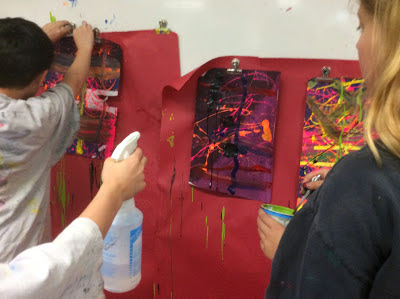Like all children everywhere, my students love,
love clay. I use it constantly, the steady Skutt kiln chugging along to keep us in business. First graders recently studied Kente cloth in art class, and the design elements are very transferable to clay textures.
These vases are fully glazed and intended to be used. Forming the basic cylinder shape was the building challenge. To help hold it in place we used cardboard tubes.
To make this cylinder, I taught first graders how to
stretch a slab. Although this was a skill that I learned at a much later age (as in, high school), I decided to give it a whirl with these marvelous kiddos, and most of them did a fantastic job at it. Anyone who preferred to could also use a rolling pin to create a long, thin rectangle.
That rectangle was then wrapped around the tube, and a small circle was added to the end to create the bottom. If you were to take the tube out at this point, it would look like this.
That would be fine, but we kept our tube in a little longer so that we could add texture. Using both traditional clay tools and household objects like forks, artists added designs to the clay, being careful to not cut too deeply through to the cardboard. Although, if that happens, it could still make a nifty pencil holder.
I usually take out the cardboard while the clay is still a little damp. Clay shrinks as it dries and can crack if you leave the cardboard inside. Sometimes these are hard to wrestle out, so no worries if you do leave it in, it will just burn up in the kiln.
After they come out of the kiln, they are white like the ones above, and I teach students how to coat the whole vase and wash away the high spots, leaving glaze in the textures. It's not a requirement, but it is another design choice they can try to highlight the texture patterns, at which point it looks about like this one below.
Additional glaze in a different color can be put all over, and the textures will still show after firing.
The one area students have to glaze fully is in the inside, to allow it to hold water. Students can achieve a fun range of colors when they begin to overlap the glazes.
Clay projects are particularly important to do with the youngest artists. The material requires lots of pressure to manipulate, which helps build the strength needed to support finer tasks like handwriting.
Clay work promotes hand-eye coordination, attention to detail, and concentration.
It is therapeutic and forgiving- it is just mud after all, so if you mess it up, squish and begin again.
The same basic building technique could also be used to make cups, mugs, and containers with lids, simply by changing the diameter of the cardboard tube and the decorative techniques you try. And if you are lucky to live near a river (or maybe even have too much in your yard!) clay is free! Dig some up, throw it in a bucket and keep it damp for kids to play with. It doesn't even have to be fired to be fun. If it dries out, let it soak in water for a day or two and it will be ready again to play with.





















































